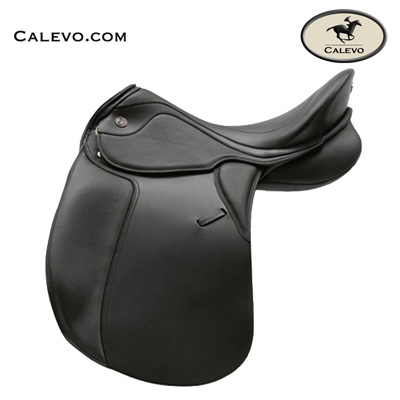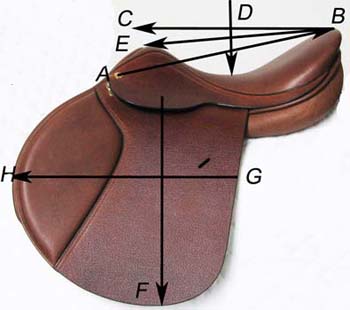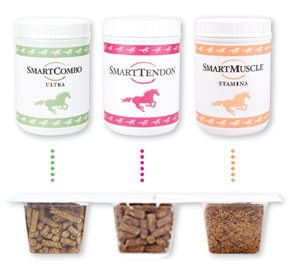If you have your own pony, the saddle should fit the pony. Fitting the rider is important but fitting the pony is more important. A poorly fitting saddle can give the pony a sore back, making him cranky and unwilling to work. If the saddle doesn't fit the rider, she will fight the saddle and find it difficult to use her seat properly. I experienced this for the first time this winter which prompted me to buy my own saddle, something I longed to own for nearly 30 years. I tried about 10 saddles from Dover Saddlery and found that some were a terrible fit for me and others were great. Buying saddles is process and can take time. It can be frustrating but it is worth doing the work to find the right saddle for you and your horse.
 |
| Basic Jump Saddle |
 |
| Dressage saddle without stirrups |
Each brand of saddle is a little different and they start with different shapes. Some are very flat, some are very rounded or narrow. There are the brands sold in retails stores and there are the higher end custom saddle brands. Saddles can be purchased from retails
stores, saddle makers, saddle fitters and consignment shops. Buying a saddle from a consignment shop is a great way to go if you can find the proper fit for your horse. There's a place in New Hampshire called Pelham Saddlery. They have an amazing selection of used saddles and will come to you with saddles for a reasonable fee which is waved if you buy a saddle from them.
The saddles sold in retail stores - Collegiate, Pessoa, Stubben, Bates - while pricey, are less expensive than custom brands such as County, Black Country and about 100 more. A decent retail store saddle will cost between $1000 - $2000 and more. Custom saddles are about $5000 new. Used saddles are often not much less than new saddles, especially if they have been well maintained. It just depends on the saddle. A major difference, besides the custom fitting and leather quality, is the flocking or padding in the "panels" under the saddle where it rests against the horse's back. Flocking is usually wool (it can be synthetic) and looks like it just came off the sheep's back. It's reasonably adjustable. Many of the retail store brands use foam, memory foam or air bags to fill the panels. Some of the retail store brands can be converted from air bags to flocking to improve fit, comfort and adjustability.
Another thing to look for is an adjustable tree or gullet. The tree itself isn't really adjustable. The tree is the hard structure the saddle is built around. The gullet plate is the metal piece at the front of the tree that can be changed. Pessoa, Bates and others offer adjustable trees. They have an opening that allows you to get into the construction of the saddle and use a screwdriver or allen wrench to take out one gullet plate and replace it with a wider, narrower, longer one. This is especially useful if you will be changing horses from time to time. Some of the custom brands have a metal piece at the crown of the tree and a good saddle fitter will be able to bend it to the shape of the horse within reason. This is not something you can do for yourself, however,
The best thing to do when buying a saddle is to contact a saddle fitter. I bought all my saddles before doing this. It worked out fine but I may have made different choices if I had spoken to her first. My daughter's first saddle was an easy purchase. We bought a little saddle used from a friend when we leased her first pony. The price was right but the saddle was really too small for my daughter. When we bought her current pony, I had a woman from Dover Saddlery bring saddles to the barn to try on him. We decided to buy both jump and dressage saddles, primarily because there happened to be an extremely well priced dressage saddle on closeout that fit both Elizabeth and her pony. We also bought at Mattes Pad with shims to help correct the fit of the both saddles. Her jump saddle happens to be a Pessoa but that was just the one that fit the pony the best though we do need to use the correction pad to get the fit he needs.
When it was my turn to buy a saddle, I chose a Bates saddle after trying several other brands. The price was reasonable considering I don't own my own horse and I had read online that Bates saddles are easily converted from air pads to flocking. It's a really nice saddle and I love riding in it.
What do saddle sizes mean? There are two main sizes - the tree size/gullet size and the seat size. The tree which is the major structure of the saddle, can be made of wood, plastic, and other hard substances, fits the horse and can be narrow, wide, flat, round, curved. Every brand tends toward its own shape. The gullet plate is the piece that can be changed in adjustable saddles, usually starting with a medium which can be changed to be narrower or wider. As long as you buy a saddle that doesn't have an extreme tree shape, changing the gullet plate and amount of flocking can go a long way to getting a saddle to fit most horses. The seat size ranges from 15 for a tiny children's saddle to an 18 and up for large men. I'm 5'7" and ride in a 17" seat. My daughter is almost 5' tall and she rides in a 16.5" seat which has a little room for her to grow. The seat is measured by stretching a tape measure from the button to the center back of the seat (A to B in the diagram above). If you are looking at dressage saddles, the flap length may become a factor. The flap measurement is F in the diagram above.
About a month ago we met with a saddle fitter. This is different than the woman from Dover who came out to try saddles on our pony for us. The saddle fitter has taken an intensive course in England and she apprenticed to an American saddle fitting legend. Over time she has developed her own approach and I found it fascinating to watch her work. Her name is Diane Williams and if you are in the New England area she is wonderful. But wherever you are, there should be good saddle fitters available to you. This is a list of saddle fitters I found on the website of yet another custom saddle maker and Diane is on the list.
The saddle fitter will first palpate the horse's back and check for sensitivity and any issues the horse might be having. The she will put the saddle on your horse without anything under it. She can see if it's sitting to high or low. She will add or remove flocking, adjust the tree. I had her convert my Bates saddle from air to flocking and she got a great fit for the horse I ride. As it turned out, the inexpensive Circuit dressage saddle I bought my daughter was flocked with synthetic fiber fill. Diane pulled some out and replaced it with wool. Again, she was able to achieve an excellent fit. My daughter no longer needs to use the Mattes Pad with this saddle and has gone from hating riding in it to finding it extremely comfortable. Elizabeth's Pessoa jump saddle, while very comfortable, has a foam construction. There was nothing Diane could do for it so Elizabeth still needs to use the Mattes Pad to get a good fit on her pony which is fine, just a little annoying. We still like Elizabeth's jump saddle and considering she will outgrow this pony and the saddle in two years, we would not have considered anything custom made. I would, however, lean towards Bates saddles in the future. I really do love mine, the prices are good, the leather is high quality, the tree is adjustable and they can be converted to wool flocking giving you the best of everything.
Once you buy a saddle, remember you will need to buy stirrups, stirrup pads and stirrup leathers. Leathers come in a variety of lengths so if you are buying for a child, be sure to get short leathers. You can always punch more holes but it's nice if they fit right off the bat. Stirrups also come in sizes - widths. Just pay attention to what you are buying and ask for help. You will need a quilted saddle pad to go between the horse and the saddle to keep the saddle clean and to keep it from slipping around. And of course you will need a girth. We like fuzzy girths and prefer the Toklat girth for our jumping saddles. They are washable and comfortable for the horse. If you buy a dressage saddle, the girth will be 20 inches shorter than a jump girth, most likely black to match the saddle and the pad may need to be a bit bigger to accommodate the longer flaps. This is a good article on choosing the proper girth.
And now that you own a saddle, you need to take care of it! Saddles that are kept clean and conditioned will last a lifetime. In our house we clean saddles with glycerin soap, oil the billets, flaps and leathers and condition the seat with Lexol conditioner and oil. There are a ton of great products on the market. Some people prefer to clean with specially designed leather cleaners such as Effax Combi. Check out your local tack store and talk to a pony clubber to find out more about serious tack cleaning.
Congratulations on your huge purchase! Happy riding!
Kristie











